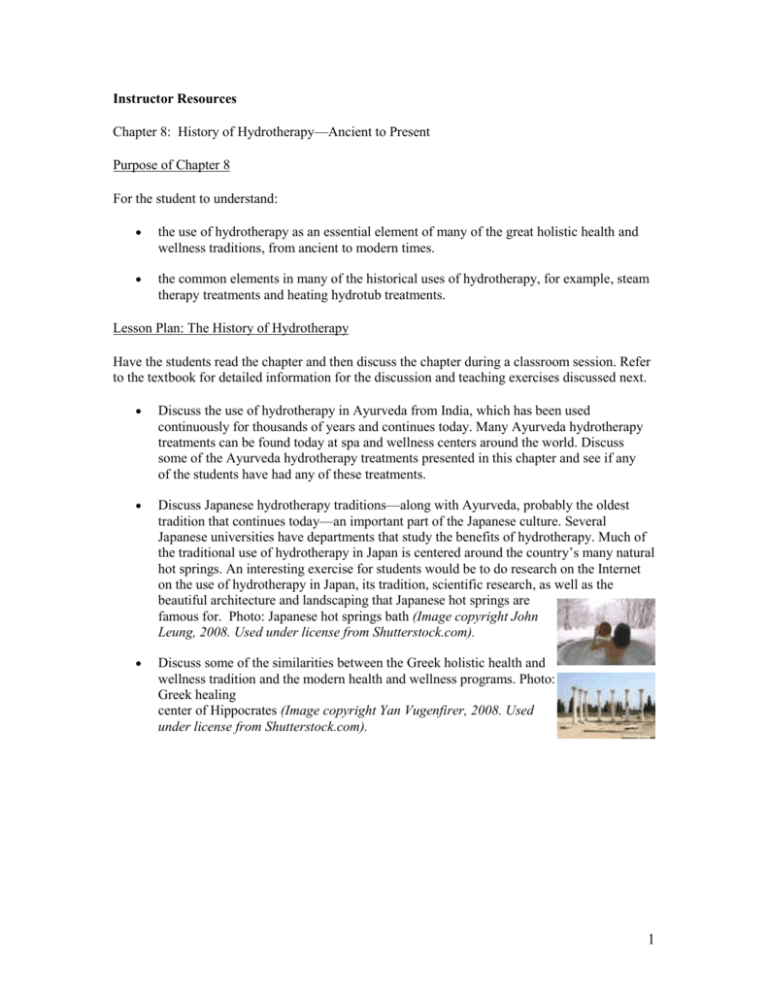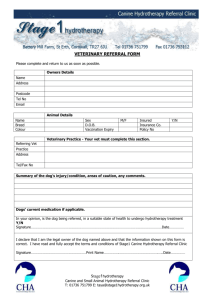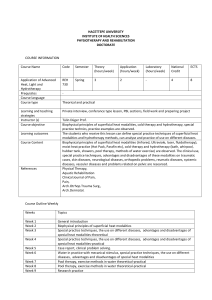Chapter 08 IR
advertisement

Instructor Resources Chapter 8: History of Hydrotherapy—Ancient to Present Purpose of Chapter 8 For the student to understand: the use of hydrotherapy as an essential element of many of the great holistic health and wellness traditions, from ancient to modern times. the common elements in many of the historical uses of hydrotherapy, for example, steam therapy treatments and heating hydrotub treatments. Lesson Plan: The History of Hydrotherapy Have the students read the chapter and then discuss the chapter during a classroom session. Refer to the textbook for detailed information for the discussion and teaching exercises discussed next. Discuss the use of hydrotherapy in Ayurveda from India, which has been used continuously for thousands of years and continues today. Many Ayurveda hydrotherapy treatments can be found today at spa and wellness centers around the world. Discuss some of the Ayurveda hydrotherapy treatments presented in this chapter and see if any of the students have had any of these treatments. Discuss Japanese hydrotherapy traditions—along with Ayurveda, probably the oldest tradition that continues today—an important part of the Japanese culture. Several Japanese universities have departments that study the benefits of hydrotherapy. Much of the traditional use of hydrotherapy in Japan is centered around the country’s many natural hot springs. An interesting exercise for students would be to do research on the Internet on the use of hydrotherapy in Japan, its tradition, scientific research, as well as the beautiful architecture and landscaping that Japanese hot springs are famous for. Photo: Japanese hot springs bath (Image copyright John Leung, 2008. Used under license from Shutterstock.com). Discuss some of the similarities between the Greek holistic health and wellness tradition and the modern health and wellness programs. Photo: Greek healing center of Hippocrates (Image copyright Yan Vugenfirer, 2008. Used under license from Shutterstock.com). 1 Discuss how elements of the Roman hydrotherapy tradition are found in the modern European hydrotherapy tradition, and that many of the bestknown modern European hydrotherapy centers are located at the same sites (usually natural hot springs) as prior Roman hydrotherapy centers. Photo: Friedrichsbad classic thermal facility (courtesy of CAMSAN, Baderbedriebe GmbH). Discuss the popular use of hydrotherapy programs in North America between 1850 and about 1940. Key examples of this, as stated in the chapter, were Saratoga Springs, New York, and Hot Springs, Arkansas. Discuss the decline of interest in hydrotherapy programs at these and similar sites until most were closed in the 1950s. Photo: Buckstaff Bath House (courtesy of Buckstaff Hotel, Hot Springs, Arkansas). Discuss the growing interest in alternative health, including hydrotherapy, from the 1970s until the present day. Discuss how these programs are assisting people in achieving a greater range of health and wellness goals. Discuss modern challenges to health and wellness that require special health and wellness programs to deal with these issues. Exercise: This could be a discussion or the students could be asked to write a brief paper on what the history of hydrotherapy demonstrates about why it works and why it has been a key element of the well-known holistic health and wellness tradition, from ancient to modern times. Discuss how an interesting way to study the history (as well as the modern use) of hydrotherapy is to visit the famous sites of the historical and modern-day uses of hydrotherapy in such countries such as Greece (see photo), Germany, France, and Turkey. In the United States, it is possible to visit many historical sites. Hot Springs, Arkansas, features a national park that includes not only the natural hot springs, but many of the famous original wellness centers (bath houses). (See photo of the Buckstaff Bath House.) History of Hydrotherapy Internet Educational Resources: Hot Springs National Park, Hot Springs, Arkansas http://www.nps.gov/hosp/ Buckstaff Bath House, Hot Springs, Arkansas http://www.buckstaffbaths.com/ The Friedrichsbad, Baden-Baden, Germany http://www.carasana.de/home/en/roemisch.html 2 Suggested Readings Healing Springs: Altman, N. (2000). Rochester, Vermont: Healing Arts Press. This book covers much of the history of hydrotherapy in the United States and provides references to hot springs around the world. Getting Wet: Adventures in the Japanese Bath: Talmage, E. (2006). Kodansha International. This is a very interesting and creative book on current hydrotherapy traditions in Japan. REVIEW QUESTIONS & ANSWERS 1. What is a full-body steam treatment used by Ayurveda for detoxification that is still used today? Answer: Swedhana. 2. What is an inhalation treatment used by Ayurveda that is still used today? Answer: Nasya. 3. What is meant by the term holistic health and wellness? Answer: It considers the health and wellness of the “whole” person—physical, mental, emotional, and spiritual—and also uses a wider range of treatment modalities to promote holistic health and wellness. 4. What was holistic about the Greek wellness tradition? Answer: The Greeks used massage, herbs, hydrotherapy, psychology, social therapy, and sleep therapy. 5. What do some of the modern spas and wellness centers have in common with the Roman traditions? Answer: They use heating and cooling hydrotherapy treatment, relaxation, and resting. 6. What is a famous hydrotherapy treatment from France that is named after the city where the treatment originated? Answer: Vichy shower. 7. What is the name of the well-known city that was part of the early history of hydrotherapy in the United States, that is now a national park? Answer: Hot Springs, Arkansas. 8. Discuss why there was such a decline in the popularity and use of hydrotherapy in the United States between 1930 and 1950, when at the same time, hydrotherapy continued to be popular in Europe. Answer: One main reason was that modern drugs were thought to be able to treat and cure diseases and deal with other health problems. Health approaches such as hydrotherapy became less popular. Also, people became less interested in “health vacations” as more vacations options became available. 9. Discuss the current increased interest in alternative health approaches and how hydrotherapy, which has a long tradition of use for health and wellness, can play a role in the ongoing development of these programs. Answer: The original promise of modern drugs for treatment and to deal with a wide range of health and wellness goals has not unfolded as expected, with additional complications of the major side effects of drugs and other issues. Once again, people are looking at the long traditional use of time-tested forms of alternative health approaches, such as hydrotherapy, to allow them to achieve and attain their fundamental health and wellness goals. 3





